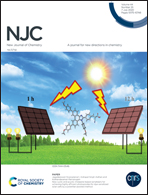Fe/Fe3C encapsulated in nitrogen source-mediated active-N-rich defective carbon nanotubes for bifunctional oxygen catalysis†
Abstract
Developing highly efficient non-precious metal bifunctional catalysts towards both the oxygen reduction reaction (ORR) and oxygen evolution reaction (OER) is vital for pushing the development of Zn–air batteries. Here, we propose a nitrogen source-mediated strategy to synthesize active-N-rich defective carbon nanotube encapsulated Fe/Fe3C nanoparticles (denoted as Fe-N-OCNT) via one-step pyrolysis of OCNTs, Fe-Phen and an additional small molecule nitrogen source. N-source-regulated N configuration and steric hindrance effect of Fe-Phen coordination structures is proved to be a key factor affecting the electrocatalytic activity towards ORR and OER. The resulting Fe-N-OCNT exhibits a high half-wave potential of 0.86 V (vs. RHE) for ORR, and a low overpotential of 0.353 V for OER as well as a reversible oxygen electrode index of 0.723 V, superior to those of most recently reported advanced bifunctional catalysts. Multiple active component Fe/Fe3C cores strongly synergized with active N-rich carbon layers are responsible for the superior bifunctional electrocatalytic activity by forming a favorable interfacial electron interaction. Impressively, the assembled Zn–air batteries with the Fe-N-OCNT catalyst as the bifunctional air electrode deliver excellent charging–discharging performance, high power density (128.8 mW cm−2), energy density (779.3 W h kg−1) and long lifespan, demonstrating great potential for practical implementation.



 Please wait while we load your content...
Please wait while we load your content...